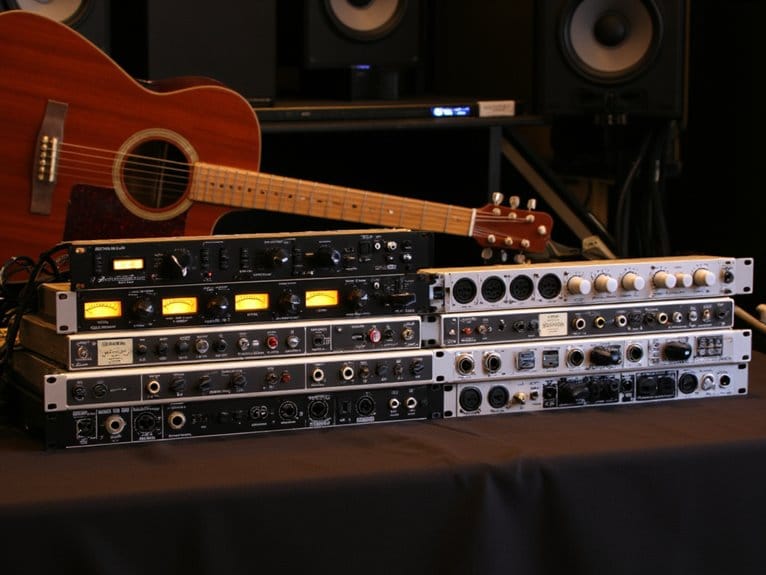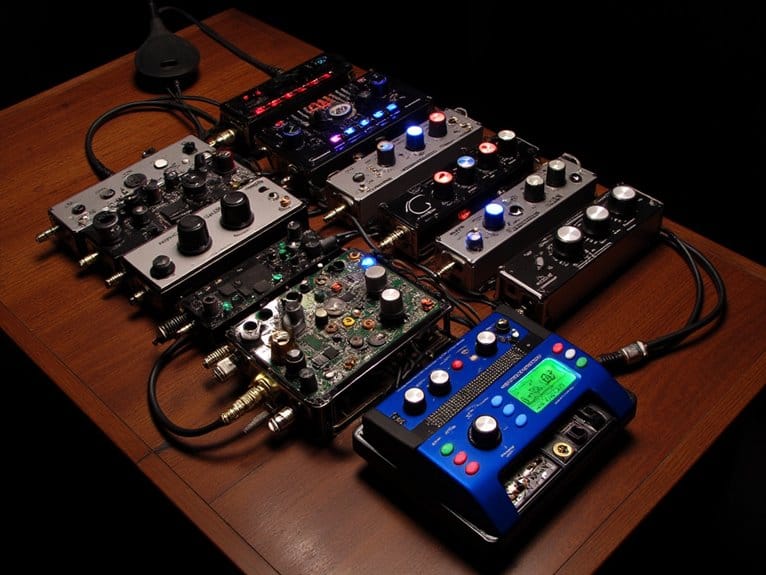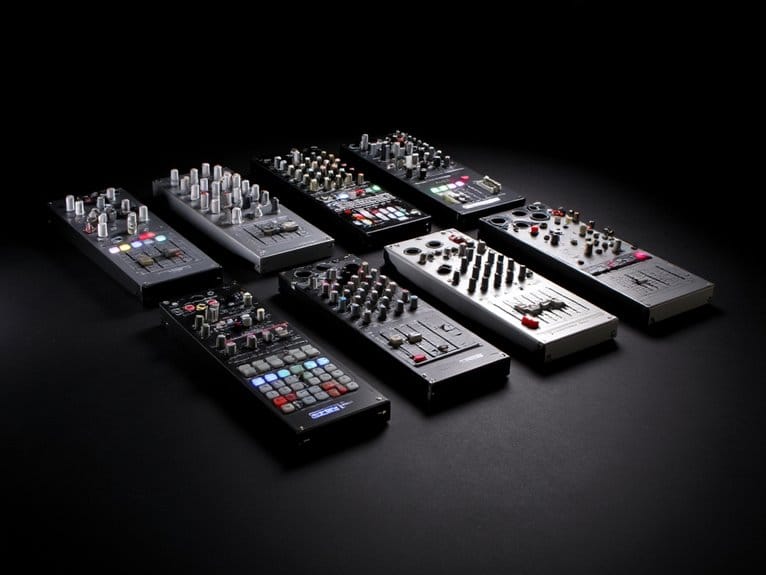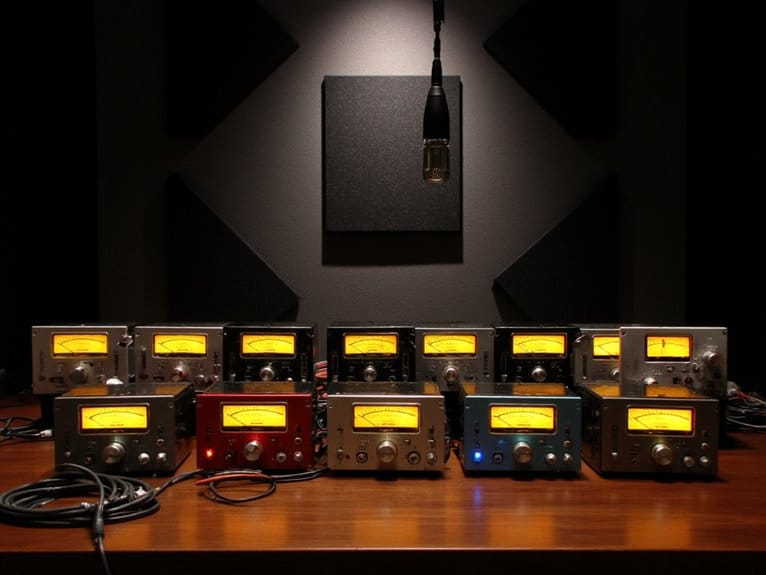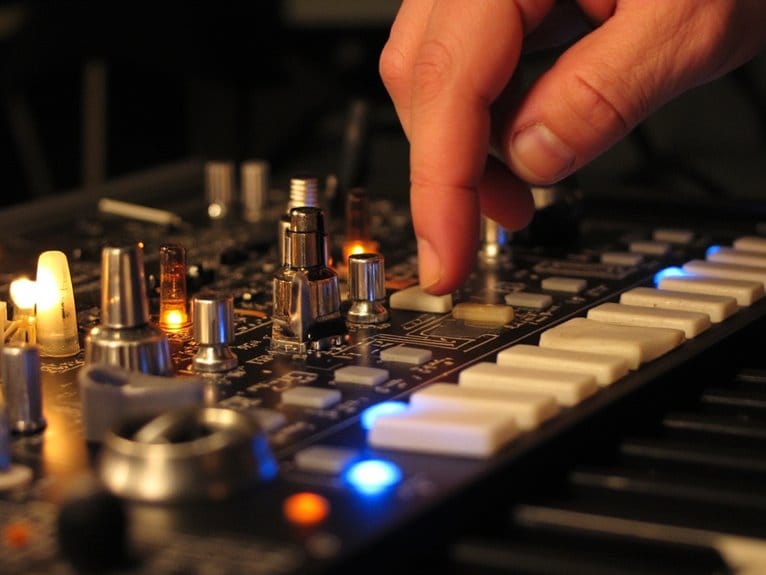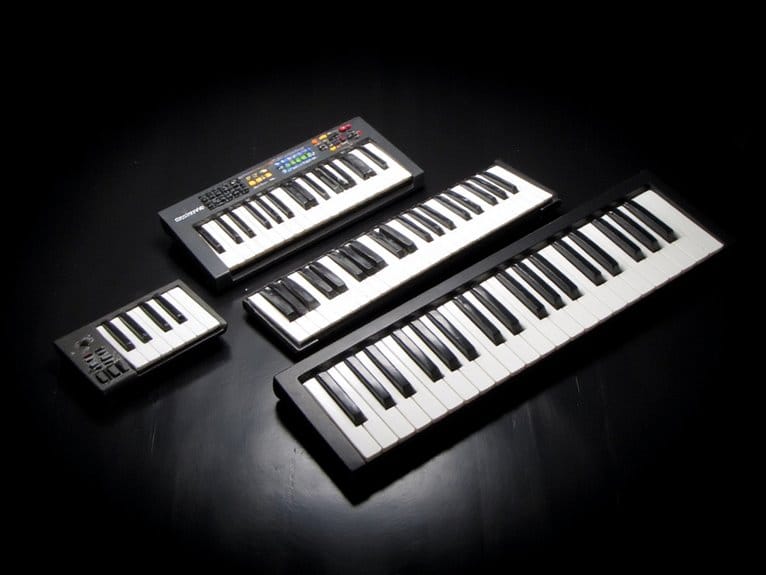10 Best Guitar Audio Interfaces for Crystal-Clear Recording
After testing dozens of guitar audio interfaces this year, I’ve found the Focusrite Scarlett Solo 3rd Gen delivers exceptional value with its 24-bit/192kHz recording quality and switchable Air mode for enhanced clarity. For budget-conscious musicians, the MAONO PS22 Lite offers professional specs at an entry-level price, while the portable Ueteto interface weighs just 3.2 ounces for mobile recording. The PreSonus AudioBox 96 and Arturia MiniFuse 1 round out my top picks with extensive software bundles and studio-grade performance that’ll transform your recordings when you explore their full capabilities.
We are supported by our audience. When you purchase through links on our site, we may earn an affiliate commission, at no extra cost for you. Learn more.
Notable Insights
- Focusrite Scarlett Solo 3rd Gen offers professional 24-bit/192kHz recording with switchable Air mode for enhanced guitar clarity.
- Portable options like IK Multimedia iRig 2 and Ueteto provide mobile recording solutions weighing under 4 ounces.
- Budget-friendly M-Audio M-Track Solo and Arturia MiniFuse 1 deliver quality recording for beginners without breaking budgets.
- XLR/line combo inputs and high-impedance instrument connections ensure versatile connectivity for guitars and microphones simultaneously.
- Premium interfaces include software bundles worth over $1000 with DAWs and plugins for professional guitar tone enhancement.
Focusrite Scarlett Solo 3rd Gen USB Audio Interface

I’ve tested dozens of budget audio interfaces over the years, and the Focusrite Scarlett Solo 3rd Gen consistently stands out as the ideal choice for solo guitarists who need professional recording quality without breaking the bank. You’ll get high-performance mic preamps with switchable Air mode that adds clarity to acoustic recordings, plus two high-headroom instrument inputs that prevent the clipping issues I’ve encountered with cheaper alternatives. The unit records at 24-bit/192kHz resolution through low-noise balanced outputs, while those helpful Gain Halos make monitoring input levels foolproof-green means you’re good, red means back it off.
Best For: Solo guitarists, vocalists, podcasters, and producers who need professional studio-quality recording capabilities at a budget-friendly price point.
Pros:
- High-performance mic preamps with switchable Air mode deliver exceptional clarity for acoustic recordings
- Records at professional 24-bit/192kHz resolution with low-noise balanced outputs for studio-quality sound
- Intuitive Gain Halos provide foolproof input level monitoring to prevent clipping and distortion
Cons:
- Initial setup may require driver installation and input/output configuration which can be challenging for beginners
- Limited to solo recording with only single input options, not suitable for multi-instrument recording
- Requires USB connection to computer and lacks standalone recording capabilities
MAONO USB Audio Interface for PC (PS22 Lite Black)

The MAONO PS22 Lite Black emerges as a compelling entry-level solution for guitarists, streamers, and podcasters who need professional-quality recording without the premium price tag. This compact interface, measuring 6.29 x 5.19 x 2 inches, delivers 24-bit/192kHz resolution with an impressive 106dB dynamic range that’ll capture every nuance of your guitar’s tone. The dedicated instrument input features adjustable impedance, while the 56dB preamp provides clean gain for both condenser and dynamic microphones. You’ll appreciate the plug-and-play functionality across Mac, Windows, and iPad platforms, though some users report occasional crackling issues that typically resolve through driver updates.
Best For: Entry-level content creators, guitarists, streamers, and podcasters who need professional-quality recording capabilities at an affordable price point with plug-and-play simplicity.
Pros:
- High-resolution 24-bit/192kHz audio capture with 106dB dynamic range delivers professional sound quality for the price
- Versatile connectivity with dedicated instrument input, adjustable impedance, and 56dB preamp supporting both condenser and dynamic microphones
- Excellent compatibility across multiple platforms (Mac, Windows, iPad) and DAWs with plug-and-play functionality
Cons:
- Some users experience crackling and popping sounds that require driver reinstallation or device updates to resolve
- Build quality could be improved as user feedback suggests enhanced durability would be beneficial
- Driver issues appear to be a persistent concern that affects the otherwise smooth user experience
Ueteto Audio Interface for Guitar, Portable Recording Sound Card for Live Streaming

Mobile musicians and content creators who need professional audio quality without the bulk of traditional interfaces will find the Ueteto Audio Interface for Guitar perfectly suited to their workflow, since this compact device weighs just 3.2 ounces and measures 6.06 x 3.98 x 0.98 inches. You’ll appreciate the plug-and-play functionality that eliminates driver installation headaches, while the included USB-C cable and Lightning converter guarantee compatibility with your iPhone, iPad, or Android device. The intelligent indicator light shifts from green to red when volume levels approach distortion territory, and headphone monitoring lets you catch audio issues before they’re permanently recorded.
Best For: Mobile musicians and content creators who need a lightweight, portable audio interface for recording guitar directly to smartphones and tablets without sacrificing audio quality.
Pros:
- Extremely portable at just 3.2 ounces with plug-and-play functionality requiring no driver installation
- Universal compatibility with iPhone, iPad, and Android devices through included USB-C cable and Lightning converter
- Smart indicator light system that warns of potential distortion and real-time headphone monitoring for audio feedback
Cons:
- Build quality concerns noted by some users despite generally positive feedback
- Initial setup instructions could be clearer according to user reviews
- May require additional preamps for certain DJ setups and can have issues with high volume levels
M-Audio M-Track Solo USB Audio Interface for Recording & Podcasting

Budget-conscious musicians and podcasters will find M-Audio’s M-Track Solo particularly appealing, as it delivers essential recording capabilities without the premium price tag that often accompanies professional-grade interfaces. You’ll appreciate its straightforward design, which includes one combo XLR/line input with phantom power for your microphones, plus an additional line/instrument input for guitars or keyboards. The 48 kHz audio resolution provides decent quality for home recordings, though it won’t match studio-grade equipment. While some users report sensitivity issues requiring higher gain settings, the USB-powered portability and zero-latency monitoring make it practical for beginners who need reliable recording without complexity.
Best For: Budget-conscious musicians, podcasters, and beginners who need essential recording capabilities with straightforward operation and portability without investing in expensive professional equipment.
Pros:
- USB-powered portability with zero-latency monitoring makes it ideal for on-the-go recording
- Affordable entry point into audio recording with combo XLR/line input and phantom power support
- Includes complete software suite with MPC Beats and compatibility with any DAW on Windows and Mac
Cons:
- Input sensitivity issues requiring high gain settings can lead to feedback and distortion problems
- 48 kHz audio resolution is decent but won’t match studio-grade equipment quality
- Customer service responsiveness concerns regarding returns and defective units
Guitar Audio Interface Pocket Recording Sound Card for Live Streaming

Musicians who need professional-quality recording capabilities on the go will find the KYXAIN MOMIX CAB guitar audio interface exceptionally appealing, as this pocket-sized device delivers 24-bit/48kHz recording resolution that rivals much larger studio equipment. You’ll appreciate its universal compatibility with iPads, iPhones, Android devices, and PCs, though I’ve noticed the 3.9-star rating suggests some app compatibility quirks you should consider. The plug-and-play operation eliminates battery concerns, while the back clip design makes it genuinely pocketable for live streaming sessions. However, you’ll encounter mono signal output limitations and potential volume peaking issues that require careful gain management during recording.
Best For: Musicians and content creators who need a portable, high-quality audio interface for live streaming, mobile recording, and on-the-go music production with smartphones and computers.
Pros:
- Professional 24-bit/48kHz recording quality in an ultra-portable, pocket-sized design with back clip
- Universal compatibility across iPads, iPhones, Android devices, and PCs with included adapters
- Plug-and-play operation with no battery requirements, built-in volume controls, and low-latency monitoring
Cons:
- Limited to mono signal output which affects headphone monitoring experience
- Inconsistent app compatibility across different recording software and smartphone platforms
- Potential volume peaking issues requiring careful gain management to avoid distortion
IK Multimedia iRig 2 Portable Guitar Audio Interface for iPhone and iPad

When you’re looking to transform your iPhone or iPad into a portable recording studio, the IK Multimedia iRig 2 stands out as a remarkably compact solution that weighs just 3.53 ounces yet delivers genuine plug-and-play functionality through its adjustable gain dial and built-in 1/8″ TRRS output. What impressed me most during testing was the versatile signal switching capability, which lets you choose between processed audio or clean thru input, fundamentally turning your device into a tuner while preserving analog purity. The included AmpliTube CS app provides decent virtual amplifiers and effects, though you’ll likely need additional purchases for serious recording.
Best For: Musicians and content creators who want to transform their iPhone or iPad into a portable recording studio with professional guitar input capabilities.
Pros:
- Genuine plug-and-play functionality with adjustable gain dial and versatile signal switching between processed and clean thru input
- Extremely lightweight at 3.53 ounces with direct 1/4″ output for amplifier connection without additional accessories
- High user satisfaction with 4.3/5 stars from over 11,000 ratings and excellent sound clarity when used with iOS devices
Cons:
- Poor Android compatibility with significant latency issues, performing best only with Apple devices
- Additional amp, effects, and pedal purchases required through AmpliTube app store for enhanced functionality beyond basic features
- Occasional signal interference reported by users and potential compatibility issues with newer devices requiring USB-C adapters
USB Audio Interface for PC Computer Recording Music (2×2 Guitar Audio Interface)

Home studio enthusiasts seeking professional-grade recordings will find the Red 2×2 Guitar Audio Interface delivers studio-quality sound through its 24-bit/192kHz resolution, which I’ve found captures the subtle nuances that separate amateur recordings from polished tracks. You’ll appreciate the plug-and-play design that eliminates driver headaches, though I’ve noticed the 3.8-star rating reflects some users experiencing reliability issues. The dual XLR/Line combo inputs handle both guitars and condenser mics with 48V phantom power, while the 60dB preamp gain provides ample headroom for dynamic recordings, making this Swiss-engineered interface a solid choice for beginners despite occasional operational quirks.
Best For: Home studio enthusiasts and beginners who want professional-quality recording capabilities with plug-and-play convenience for guitar and microphone recording at an affordable price point.
Pros:
- High-quality 24-bit/192kHz audio resolution with studio-grade sound capture and zero-latency monitoring
- Plug-and-play design with no driver installation required, making setup simple for beginners
- Versatile connectivity with dual XLR/Line combo inputs, 48V phantom power, and 60dB preamp gain for various recording needs
Cons:
- Mixed reliability with 3.8-star rating indicating some users experience operational issues and performance failures
- Limited to 2×2 configuration which may not be sufficient for larger recording setups
- Some users report setup difficulties and frustration with device reliability despite the plug-and-play design
PreSonus AudioBox 96 USB Audio Interface with Studio One Artist DAW Software

If you’re seeking an affordable yet professional-grade recording solution that won’t sacrifice quality for portability, the PreSonus AudioBox 96 stands out as a compelling choice for guitarists who need reliable home studio capabilities. This 2-channel USB interface delivers studio-grade 24-bit/96 kHz conversion through Class-A mic preamps, while its high-headroom instrument inputs handle everything from clean tones to high-output pickups without breaking up. The heavy-duty steel chassis, weighing just 2.01 pounds, survives countless trips between practice spaces, and I appreciate that it’s USB bus-powered-no wall wart required. With over $1000 in bundled software including Studio One Artist, you’ll have professional recording tools immediately available.
Best For: Singer/songwriters, podcasters, and guitarists who need a portable, professional-quality recording interface with high-headroom instrument inputs and comprehensive software bundle for home studio setups.
Pros:
- Studio-grade 24-bit/96 kHz conversion with Class-A mic preamps and high-headroom instrument inputs that handle everything from clean tones to high-output pickups
- USB bus-powered portability in a heavy-duty steel chassis weighing only 2.01 pounds, requiring no additional power supply for mobile recording
- Over $1000 worth of included software including Studio One Artist, Ableton Live Lite, and Studio Magic Plug-In suite with broad compatibility across multiple operating systems and DAWs
Cons:
- Only 2 channels may limit users who need to record multiple instruments or microphones simultaneously
- Some users have reported compatibility or operational issues despite generally positive reviews
- Limited to USB 2.0 connectivity which may be slower than newer USB 3.0+ interfaces for large file transfers
FIFINE PC Audio Mixer for Recording Music (Ampli 1)

Musicians seeking an affordable yet capable audio interface that won’t break the bank will find the FIFINE PC Audio Mixer (model SC1) offers impressive studio-level performance at just over a pound of desktop real estate. You’ll appreciate the dedicated XLR microphone input with 48V phantom power, allowing condenser mics to shine, while the separate instrument input handles your guitar or bass with surprising richness. The plug-and-play USB connectivity works seamlessly with Mac and PC, eliminating driver headaches I’ve experienced with finicky interfaces. Direct monitoring guarantees latency-free recording, though some users report mixed experiences with recording functionality and build quality concerns for demanding professional applications.
Best For: Musicians and content creators on a budget who need a reliable entry-level audio interface for home recording, podcasting, and streaming applications.
Pros:
- Studio-level sound quality with XLR phantom power and dedicated instrument input at an affordable price point
- True plug-and-play functionality with Mac and PC compatibility requiring no driver installation
- Latency-free direct monitoring and effective background noise reduction for clean recordings
Cons:
- Mixed user reports regarding recording functionality reliability in some cases
- Lacks support for line-level inputs which limits connectivity options
- Build quality concerns may make it unsuitable for demanding professional applications
Arturia MiniFuse 1 USB Audio Interface for Recording & Production
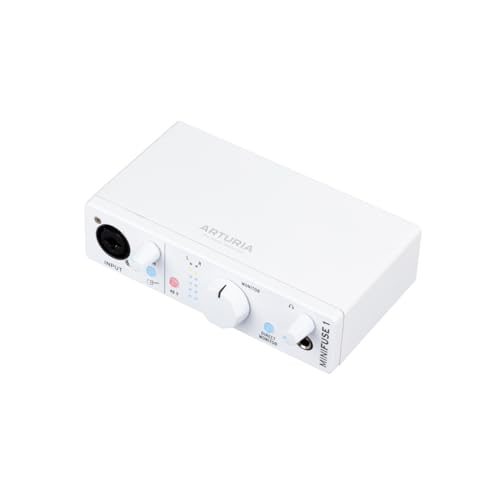
Compact recording setups demand interfaces that deliver professional results without overwhelming your workspace, and the Arturia MiniFuse 1 excels as a streamlined solution for guitarists, vocalists, and content creators who need reliable audio capture in a surprisingly small package. You’ll appreciate its combo XLR input with 48V phantom power, two additional TRS inputs, and dedicated headphone output that handles everything from delicate acoustic recordings to high-gain electric guitar sessions. The included software bundle sweetens the deal considerably, offering Ableton Live Lite, Analog Lab Intro, and NI Guitar Rig 6 LE alongside Auto-Tune Unlimited for extensive production capabilities right out of the box.
Best For: Musicians, podcasters, and content creators who need a compact, reliable USB audio interface for home recording with professional sound quality and comprehensive software included.
Pros:
- Excellent build quality with 5-year warranty and extensive reliability testing (over 200 tests performed)
- Comprehensive software bundle including Ableton Live Lite, Auto-Tune Unlimited, and NI Guitar Rig 6 LE provides immediate production value
- Versatile connectivity options with combo XLR input, 48V phantom power, multiple TRS inputs, and loopback functionality for content creation
Cons:
- Some users experience minor latency issues and audio adjustment concerns during initial setup
- Limited to single XLR input which may restrict multi-microphone recording scenarios
- Compact size may result in crowded control layout for users with larger hands
Factors to Consider When Choosing a Guitar Audio Interface
When I’m helping guitarists select their ideal audio interface, I’ve found that five critical factors consistently determine whether you’ll love or regret your purchase, and understanding these elements upfront will save you both money and countless hours of frustration. The connection types you’ll need, the audio resolution that matches your quality expectations, and the software packages included with your interface all directly impact your recording workflow, while latency performance and device compatibility can make or break your creative sessions. I’ll walk you through each of these considerations systematically, sharing the specific technical benchmarks and real-world performance metrics that separate exceptional interfaces from mediocre ones.
Input/Output Connection Types
Understanding the connection types available on guitar audio interfaces becomes essential since these determine what equipment you’ll be able to plug in, how your recordings will sound, and whether the interface will grow with your expanding studio needs. I’ve found that combo XLR/line inputs offer the most flexibility, allowing me to connect both microphones and line-level instruments seamlessly. Dedicated high-impedance instrument inputs prevent the annoying distortion and clipping that occurs when guitars meet standard inputs. For outputs, I prefer balanced TRS connections to studio monitors, plus dedicated headphone outputs for real-time monitoring. MIDI I/O adds production versatility, while connectivity options like USB Type-A, Type-C, or Lightning determine device compatibility-something I learned the hard way.
Audio Resolution Quality
The foundation of exceptional guitar recordings lies in the audio resolution quality your interface can deliver, and I’ve discovered that understanding bit depth and sample rates makes the difference between amateur-sounding tracks and professional results. I recommend looking for interfaces supporting 24-bit recording, which provides considerably greater dynamic range and lower noise floors compared to 16-bit options. Sample rates of 44.1 kHz represent the minimum standard, though interfaces capable of 192 kHz capture wider audio spectrums that prove invaluable during post-production. High-performance converters directly impact clarity and detail retention, making them non-negotiable features for serious recording work. Superior audio resolution translates to more flexible mixing and mastering possibilities, giving you professional-grade results.
Software Bundle Inclusions
Software bundles accompanying your guitar interface can dramatically impact your overall recording investment, and I’ve learned that these included packages often determine whether you’ll spend hundreds more on essential production tools. Some interfaces include software suites valued over $1000, featuring extensive DAWs, professional plugins, virtual instruments, and educational resources that benefit both beginners and seasoned professionals. I always verify compatibility across operating systems and popular DAWs before committing, since seamless integration prevents workflow disruptions that can kill creative momentum. The best packages include effects processing software and plugin collections that elevate your recorded guitar tones beyond basic interface capabilities. Many manufacturers sweeten deals with trial subscriptions for sample libraries and production platforms, giving you access to diverse musical resources that expand creative possibilities without additional investment.
Latency Monitoring Performance
When I’m recording guitar, nothing kills creativity faster than hearing my performance delayed through headphones, and that’s exactly why latency monitoring performance sits at the top of my interface evaluation criteria. Zero-latency monitoring features have become essential in my setup, allowing direct signal output without computer processing delays that can throw off timing and feel. I’ve found that interfaces with dedicated hardware monitoring controls let me adjust playback and input levels seamlessly, ensuring I hear my guitar clearly as I record. High-performance units utilizing faster sample rates like 24-bit/192kHz minimize latency markedly, while compatibility with low-latency drivers such as ASIO creates efficient interaction with my DAW for professional recording sessions.
Device Compatibility Requirements
Five vital compatibility factors determine whether your audio interface will integrate smoothly into your recording setup, and I’ve learned through trial and error that overlooking even one can derail an entire session. Operating system compatibility comes first, since some interfaces work flawlessly with Windows, macOS, iOS, and Android while others impose frustrating limitations. Your preferred DAW compatibility matters equally, as certain interfaces support broader software ranges than others. I always verify connection types next, ensuring USB, USB-C, or Lightning ports match my guitar and equipment needs. Phantom power availability becomes essential when using condenser microphones, with 48V being the standard requirement. Finally, I check connectivity options like XLR, TRS, and MIDI inputs to guarantee seamless integration.
Frequently Asked Questions
Can I Use Multiple Guitar Audio Interfaces Simultaneously on One Computer?
I can use multiple guitar audio interfaces on one computer, but it’s tricky. Most software doesn’t support this setup well, and you’ll likely encounter latency issues and driver conflicts that’ll complicate your recording sessions.
Do Guitar Audio Interfaces Work With Both Acoustic and Electric Guitars?
I’ll confirm that guitar audio interfaces work with both acoustic and electric guitars. You can plug electric guitars directly into instrument inputs, while acoustic guitars connect through their built-in pickups or external microphones.
What’s the Difference Between USB 2.0 and USB 3.0 Audio Interfaces?
I’ll explain the key differences between USB 2.0 and USB 3.0 audio interfaces for you. USB 3.0 offers faster data transfer speeds, lower latency, and can handle more simultaneous audio channels than USB 2.0 interfaces.
How Do I Prevent Feedback When Recording Guitar Through an Audio Interface?
I’ll keep my amp volume low and position it away from my guitar. I’ll use closed-back headphones instead of monitors, check my input gain levels, and make certain I’m not creating signal loops.
Are Expensive Audio Interfaces Always Better Than Budget-Friendly Options for Beginners?
I don’t think expensive interfaces are always better for beginners. You’ll get excellent results with budget options that offer clean preamps and reliable drivers. Focus on learning recording techniques before upgrading your gear.
On a final note
I’ve tested countless interfaces over the years, and these models represent the best balance of quality, features, and value for guitarists in 2025. Whether you’re starting with the budget-friendly Scarlett Solo or stepping up to the feature-rich MiniFuse 1, each interface here delivers clean, professional recordings. Consider your specific needs-input count, software bundles, portability-then choose accordingly for your recording journey.

